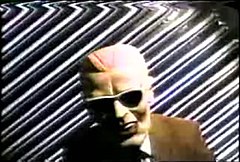 The unidentified hijacker dressed to resemble Max Headroom in the pirate broadcast | |
| Date | November 22, 1987 |
|---|---|
| Location | Chicago, Illinois, U.S. |
| Target | WGN-TV WTTW |
| Participants | At least 3 (unidentified) |
The Max Headroom signal hijacking (also known as the Max Headroom incident) was a hijacking of the television signals of two stations in Chicago, Illinois, on November 22, 1987, that briefly sent a pirate broadcast of an unidentified person wearing a Max Headroom mask and costume to thousands of home viewers.[1][2][3][4]
The first incident took place during the sports segment of independent TV station WGN-TV's 9:00 p.m. newscast. Like the later signal intrusion, it featured a person wearing a mask swaying erratically in front of a semi-swiveling corrugated metal panel, apparently meant to resemble Max Headroom's animated geometric background. Unlike the later intrusion, the only sound was a loud buzz. This interruption went on for almost 17 seconds before engineers at WGN were able to regain control of their broadcast tower.
The second incident occurred about two hours later during PBS member station WTTW's broadcast of the Doctor Who serial Horror of Fang Rock. With nobody on duty at the affected tower, this signal takeover was more sustained and the masked figure could be heard making reference to the real Max Headroom's advertisements for New Coke, the animated TV series Clutch Cargo, WGN sportscaster Chuck Swirsky, "Greatest World Newspaper nerds", and other seemingly unrelated topics. The video concluded with the masked figure presenting his bare buttocks to a woman with a flyswatter while yelling "They're coming to get me!", with the woman responding "Bend over, bitch!" and lightly spanking him with it as the figure was crying and screaming. At that point, the hijackers ended the pirate transmission, and normal programming resumed after a total interruption of about 90 seconds.[5]
A criminal investigation conducted by the Federal Communications Commission in the immediate aftermath of the intrusion could not find the people responsible and despite many unofficial inquiries and much speculation over the ensuing decades, the culprits have yet to be positively identified.[6][7][8][9]
- ^ Cite error: The named reference
Knittelwas invoked but never defined (see the help page). - ^ Ross, Andrew (1990). "Techno-Ethics and Tele-Ethics: Three Lives in the Day of Max Headroom". In Mellencamp, Patricia (ed.). Logics of Television: Essays in Cultural Criticism. Indiana University Press. p. 138. ISBN 0-253-33617-1.
- ^ Schwoch, James; White, Mimi; Reilly, Susan (1992). Media Knowledge: Readings in Popular Culture, Pedagogy, and Critical Citizenship. SUNY Press. p. 113. ISBN 978-0-7914-0825-4.
- ^ Forester, Tom; Morrison, Perry (1994). Computer Ethics: Cautionary Tales and Ethical Dilemmas in Computing. MIT Press. p. 74. ISBN 0-262-56073-9.
[S]everal other instances of uplink video piracy have occurred [...] WTTW (Channel 11 in Chicago) was also overridden by a 90 second transmission, this time by a man in a Max Headroom mask smacking his exposed buttocks with a riding crop.
- ^ Hill, Steven Warren (2017), Red White and Who: The Story of Doctor Who in America, Cockeysville, MD: ATB Publishing, pp. 79–81
- ^ Cite error: The named reference
Shefskywas invoked but never defined (see the help page). - ^ Cite error: The named reference
Unruhwas invoked but never defined (see the help page). - ^ Cite error: The named reference
Gallagherwas invoked but never defined (see the help page). - ^ Cite error: The named reference
Haskinswas invoked but never defined (see the help page).